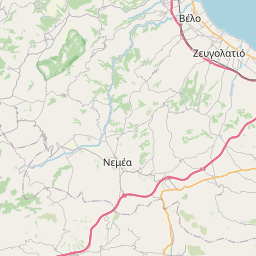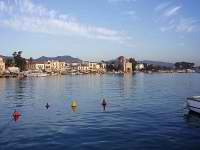Sightseeing tour to the interior of Aegina island: Kypseli-Kontos-Messagros
From Aegina town, in addition to the two directions along the coast that go northwards (Plakakia) and southwards (Perdika) and the direction towards Pacheia Rachi, there also start two roads towards the interior of the island. One goes northeast towards Kypseli. The second road starts from the former orphanage and takes us towards Kontos, with its Church of Saint Nectarios and Messagros.
Kypseli is the closest large village to Aegina town, 3km SE of the town. It was called run down due to a ruined basilica that was located close to today’s square in the village. The area is fertile and there is significant cultivation of pistachios. Aegina is famous for its pistachios. The first were grown here at the beginning of the 20th Century and their cultivation quickly spread throughout the island to the extent that today the Aeginetan pistachio is its main agricultural product. Of special interest in the centre of Kypseli village, in the square, is the Church of the Annunciation. An elegant church that was built by local craftsmen 1875-80.
On the road from Aegina towards Kypseli, we pass in front of the Leousio Foundation for the chronically sick of “Saint Nectarios”. At the crossroad of the roads opposite the Leousio, a small road leads us to the Beautiful Church. A small, single chamber basilica built in 1289 by Leontas Zigomalas in honour of Saints Theodoroi. Inside the church are saved well preserved wall frescoes. In the same area we can see the Monastery of Saint Christophoros and of the Birth of the Virgin Mary, beside the old water reservoir of the town.
Returning to Aegina town, we now follow the road towards Saint Nectarios and Messagros. We first pass by the half-demolished Church of Phaneromene, a dependency of Chrissoleontissa. In the basement area of the church, also called the Catacombs, there are two chambers dedicated to the Virgin Mary and to St Athanasia of Aegina. You may visit here but you must ask at the town (it is opened upon request!). Continuing we pass through the district of Agioi Asomatoi. A community east of Aegina town. Of special interest are the main Church of the Taxiarches and the smaller church dedicated in honour of Osia Matrona, built in 1888 by Mrs Zaphira, wife of Sotirios Likouris.
From the Church of the Taxiarches, we can make a ‘small’ detour and follow ( to our right) the signs for Megaro Gkroza. Here is a place for cultural events that was created by Nasos Gkrozas and has hosted internationally famous and accomplished musicians of classical music.
Returning and continuing on our way to Messagros, we pass in front of the small Church of Saint Eleftherios and in under 4km we can make out the most important historic and religious sight of the island, the hill of Paliachora or Palaiochora. For nearly 1,000 years the main settlement of Aegina was found on this hill. The area is very beautifully laid out with footpaths. It is worth taking a walk on them. During this lovely walking excursion, of about 120-150 minutes, we can discover 32 out of the 350 churches that used to exist, the castle on the summit with the churches of Saints Dimitrios and Georgios side by side, and a few ruined houses. A very lovely view of the surrounding areas of Aegina, and southwards, below the hill towards the splendid Church of Saint Nectarios and the Monastery of the Holy Trinity that we can visit immediately afterwards, a little further east the Convent of Saint Aikaterini and in the distance towards the village of Kontos.
Saint Nectarios (born Anastasios Kephalas) was born in Thraki, 1846. In 1889 he was elected Bishop of Pentapolis in Egypt. In 1904 he was installed in Aegina and founded the Holy Monastery of the Holy Trinity where his remains and skull have been preserved. He passed away in 1920. A long stairway takes us from the Monastery to the splendid church, of the Saint, situated lower down. The church of the Monastery has a beautiful wooden carved altar screen and Byzantine icons. Opposite the Monastery of the Holy Trinity is located the Convent of Saint Aikaterini. A little higher up is the small Church of Saint Gerasimos (1917).
From the area of Kontos, a road goes northwards and ends in Souvala, where the main road continues towards Messagros and a third road goes southwards and ends at the Holy Monastery of Chrissoleontissa. About half way through the excursion towards Chrissoleontissa, we can see to our left on a small hill, the little Church of the Transfiguration of the Saviour and to our right a dirt road takes us to the little Church of the Archangels from where a short footpath and some climbing up takes us even higher to a little church with a very beautiful view of Saint Nectarios and of Paliachora.
The Holy Monastery of the Dormition of the Virgin Mary of Chrissoleontissa is a Convent since 1935 in an area with abundant vegetation. There is an inscription on the convent’s tower that refers to the founding of the Monastery in 1403. It took its name from the location Leonti where it was built.
We come back to our road towards Messagros. A large village 9km NE of the town of Aegina. In the village there are workshops of the most important potters on the island. Of special interest for sightseeing are the Panagia Politisa and the architecturally noteworthy house of Alex. Rodakis. The house was built in 1880 and was studied by German archaeologists and by D. Pikionis for its highly developed aesthetics and its special architecture. Today it is found in a bad condition, deserted and abandoned. From Messagros, the road continues towards Aphaia (3km) or goes down northwards to Vagia (3.1km), in this way returning to the places we have already visited.















